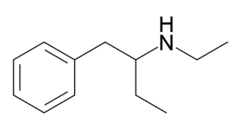N,alpha-Diethylphenylethylamine
 |
|
| Legal status | |
|---|---|
| Legal status |
|
| Identifiers | |
|
|
| Synonyms | N,α-DEPEA |
| CAS Number | 119486-07-6 29805-52-5 (HCl) |
| PubChem (CID) | 14833603 |
| ChemSpider | 27101303 |
| Chemical and physical data | |
| Formula | C12H19N |
| Molar mass | 177.285 g/mol |
| 3D model (Jmol) | Interactive image |
|
|
|
|
N,α-Diethylphenylethylamine (N,α-DEPEA, 2-ethylamino-1-phenylbutane, EAPB) is a close chemical analog of methamphetamine which has been sold as a designer drug.[1][2][3] It was originally patented by Knoll Pharma as one of several analogs for pharmaceutical applications. In animals models these analogs showed properties of cognitive enhancement and increased pain tolerance.[4] Nevertheless, this class of compounds was never developed into a medicine. N,α-DEPEA has not been studied in humans, but experts such as Pieter Cohen of Harvard Medical School expect it to be less potent than methamphetamine, but greater than ephedrine.[5]
Adulterant in nutritional supplements[edit]
In January 2013, the Korean authorities reported seizing a large quantity of the pure material, predicting it would soon be found on the market.[6] Later in 2013, it was found as an adulterant in biologically significant amounts in the pre-workout supplements Craze (marketed by Driven Sports, Inc.) and Detonate (marketed by Gaspari Nutrition).[4][7] It was falsely claimed to be Dendrobium extract.[5][8][9]
See also[edit]
References[edit]
- ^ Marzena Wójtowicz; Anna Jarek; Katarzyna Chajewska; Ewa Turek-Lepa; Dorota Kwiatkowska (November 2015). "Determination of designer doping agent – 2-ethylamino-1-phenylbutane – in dietary supplements and excretion study following single oral supplement dose". Journal of Pharmaceutical and Biomedical Analysis. 115: 523–533. doi:10.1016/j.jpba.2015.07.025. PMID 26311473.
- ^ Victor Uralets; Mike App; Sumandeep Rana; Stewart Morgan; Wayne Ross (January 2014). "Designer phenethylamines routinely found in human urine: 2-ethylamino-1-phenylbutane and 2-amino-1-phenylbutane.". Journal of Analytical Toxicology. 38 (2): 106–109. doi:10.1093/jat/bkt121. PMID 24451085.
- ^ "2-Ethylamino-1-phenylbutane". Cayman Chemical. Retrieved 4 November 2015.
- ^ a b Lee, Jaesin; Venhuis, Bastiaan J.; Heo, Sewoong; Choi, Hyeyoung; Seol, Ilung; Kim, Eunmi (2013). "Identification and quantitation of N,α-diethylphenethylamine in preworkout supplements sold via the Internet". Forensic Toxicology. 32: 148. doi:10.1007/s11419-013-0205-6.
- ^ a b "Craze manufacturer disputes NSF's discovery of drug tainting". Nutraingredients. October 17, 2013.
- ^ "Identification of N-ethyl-α-ethylphenethylamine in crystalline powder seized for suspected drug trafficking: A research chemical or a new designer drug?". Springer. January 2013.
- ^ "Popular sports supplements contain meth-like compound". USA Today. October 25, 2013.
- ^ Cohen, Pieter A.; Travis, John C.; Venhuis, Bastiaan J. (2014). "A methamphetamine analog (N,α-diethyl-phenylethylamine) identified in a mainstream dietary supplement". Drug Testing and Analysis. 6 (7–8): 805. doi:10.1002/dta.1578. PMID 24124092.
- ^ Warning issued over CRAZE sports supplement. New Zealand Herald, 13 November 2013